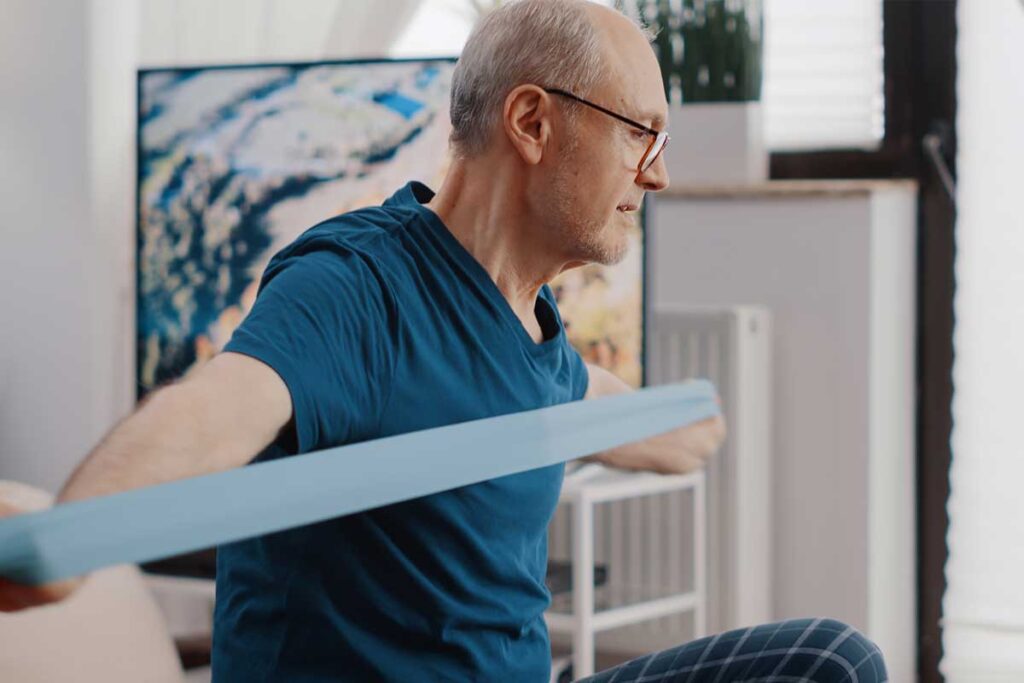Shoulder fracture in the elderly
A shoulder fracture in older adults is a serious injury that can significantly impact their quality of life. As we age, bones become weaker and more prone to injury, while reduced mobility and balance make older individuals more susceptible to falls and related injuries.
This type of injury is often the result of a fall but can also be caused by degenerative changes in the bones due to osteoporosis or arthritis. A shoulder fracture in an older person requires urgent medical attention, appropriate treatment, and long-term recovery.
In this blog, we will explain in detail what a shoulder fracture is, how it occurs, what the symptoms are, what recovery looks like, and how Vila Košuta ensures a complete recovery for older adults after such an injury.
What is a shoulder fracture?
A shoulder fracture refers to an injury to the bones that make up the shoulder joint. These include the collarbone (clavicle), the shoulder blade (scapula), and the upper arm bone (humerus). A shoulder fracture can occur as a result of falling onto the arm or from a direct blow to the shoulder joint. In older adults, bones are often weaker due to loss of bone mass, which increases the likelihood of a fracture. For those with arthritis, the bones are already degenerated, making injuries even more likely.
When a shoulder fracture occurs, a person may experience severe pain, loss of arm mobility, and potential complications if the injury is not treated properly.
Shoulder fractures in older adults can be serious, as they affect essential functions needed for daily activities. These injuries can greatly reduce quality of life, which makes early diagnosis and treatment even more important.
How shoulder fractures occur?
A shoulder fracture usually happens as a result of a fall or a blow to the shoulder joint. Older adults often experience falls due to reduced balance, decreased mobility, or other factors such as muscle weakness or bone fragility caused by osteoporosis. Falls can be triggered by clumsiness or even simple daily activities like getting up from a chair or getting out of bed. The bones of older people are more fragile and can break easily under stress, even after minor falls.
In addition, a shoulder fracture can also result from other causes such as traffic accidents or sports injuries. Traffic accidents, whether street falls or vehicle collisions, can cause severe shoulder injuries due to the force of the impact. People who engage in sports (especially older adults involved in activities that include jumping or quick movements) can also injure themselves during exercise, which may lead to a fractured shoulder.
Apart from falls and accidents, shoulder injuries can also be caused by overexertion or sudden movements during everyday activities, such as lifting heavy objects or performing certain physical tasks incorrectly. A fracture can be simple, but complications such as ligament or tendon damage may occur, making treatment more challenging and extending recovery time. If a fracture is not treated properly, it can lead to permanent deformities, reduced mobility, and chronic pain.
Types of shoulder fractures
Shoulder fractures are usually classified according to the type of injury. Based on the diagnosis, the doctor can determine the appropriate treatment and method of care.
Here are some of the main types of shoulder fractures
- Fracture of the collarbone (clavicle) – This is the most common type of shoulder fracture, usually occurring after a fall onto the arm. The fracture may be without bone displacement (no surgery required) or with displacement (requiring surgical intervention).
- Fracture of the upper arm bone (humerus) – This type requires careful medical attention, as it can involve joint damage that affects mobility. In some cases, surgery may be needed to stabilise the bone.
- Fracture of the shoulder blade (scapula) – Less common but serious, this fracture can lead to significant damage and requires intensive treatment. A scapular fracture may have longer-term effects on shoulder mobility and often requires an extended rehabilitation period.
The type of fracture determines which treatment will be applied, how long recovery will take, and what therapies will be needed to fully restore function.
Symptoms of a shoulder fracture
The symptoms of a shoulder fracture are usually quite obvious, although they can vary depending on the type and severity of the injury.
The most common symptoms include
- Severe pain in the shoulder, which worsens when moving the arm or touching the injured area. The pain can be acute and constant, interfering with normal activities.
- Swelling and bruising around the shoulder, often caused by internal bleeding.
- Inability to move the arm – In many cases, the person is unable to move the arm or experiences significantly reduced mobility, making daily tasks difficult.
- Shoulder deformity – If the fracture involves bone displacement, there may be a visible deformity of the shoulder.
- Blurred vision, dizziness, and fainting – In more severe cases, a fall can cause loss of consciousness or affect balance, further increasing the risk of serious injuries.
If a person experiences these symptoms, they should seek medical attention immediately for diagnosis and appropriate treatment.
Treatment and recovery after a shoulder fracture
Treatment for a shoulder fracture depends on the type of injury, the severity of the fracture, and the patient’s age. In most cases, the first step is immobilisation to allow the bone to heal properly. This may involve wearing a cast, a brace, or other specialised devices to stabilise the injured bone. In more severe cases, such as fractures with bone displacement, surgery may be required. The operation can involve placing metal plates, screws, or other implants to stabilise the bones.
After immobilisation, physiotherapy is key to restoring shoulder function. A physiotherapist provides targeted exercises to help restore mobility, reduce pain, and strengthen muscles. In the early stages, therapy focuses on relaxing the muscles and preventing atrophy, later progressing to muscle strengthening and improving shoulder movement.
In addition, the patient will likely undergo regular check-ups and medical examinations to ensure proper recovery. Depending on the severity of the fracture and progress in rehabilitation, recovery can take anywhere from a few months to a year.

How care homes can support recovery after a shoulder fracture?
Care homes play a key role in the rehabilitation and recovery of older adults who have suffered a shoulder fracture. By providing specialised medical and physiotherapy care, they help residents return to normal life more quickly.
- Physiotherapy – Care homes provide physiotherapists who offer tailored exercise programmes to restore arm strength and flexibility while reducing pain. The rehabilitation plan is individually adjusted to each resident’s needs to ensure the most effective recovery.
- Assistance with daily activities – During recovery, care home staff help with dressing, eating, and personal hygiene, reducing stress and speeding up the return to independence. This support is essential for older adults recovering from a fracture.
- Health monitoring – Regular checks of vital signs such as blood pressure, blood sugar, and body temperature help make recovery safer and support faster progress. Monitoring these parameters is vital to prevent complications and ensure steady improvement.
In addition to shoulder fractures, older adults are also prone to other types of fractures, such as a femur fracture, which can also have a major impact on mobility and quality of life. Similar injuries require an appropriate approach to rehabilitation and physiotherapy, as well as careful health monitoring to prevent complications and speed up recovery.
For more information about care and rehabilitation after a shoulder fracture or any other injury, feel free to contact us.
Our expert team is here to answer all your questions and provide the information you need.

